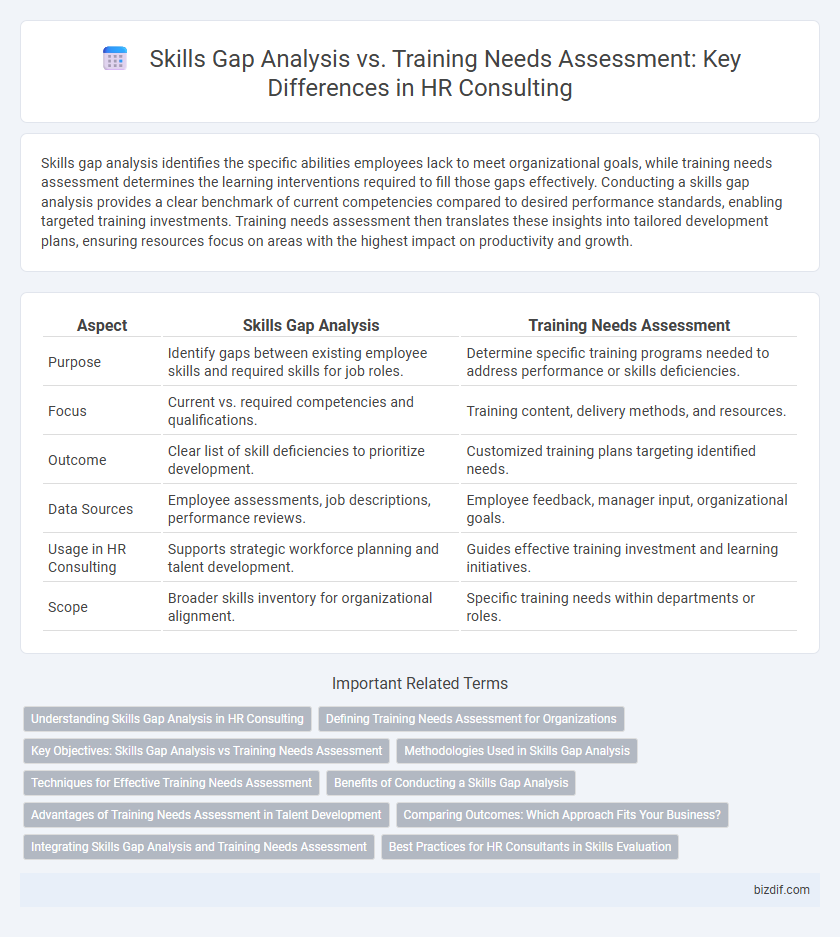Skills gap analysis identifies the specific abilities employees lack to meet organizational goals, while training needs assessment determines the learning interventions required to fill those gaps effectively. Conducting a skills gap analysis provides a clear benchmark of current competencies compared to desired performance standards, enabling targeted training investments. Training needs assessment then translates these insights into tailored development plans, ensuring resources focus on areas with the highest impact on productivity and growth.
Table of Comparison
| Aspect | Skills Gap Analysis | Training Needs Assessment |
|---|---|---|
| Purpose | Identify gaps between existing employee skills and required skills for job roles. | Determine specific training programs needed to address performance or skills deficiencies. |
| Focus | Current vs. required competencies and qualifications. | Training content, delivery methods, and resources. |
| Outcome | Clear list of skill deficiencies to prioritize development. | Customized training plans targeting identified needs. |
| Data Sources | Employee assessments, job descriptions, performance reviews. | Employee feedback, manager input, organizational goals. |
| Usage in HR Consulting | Supports strategic workforce planning and talent development. | Guides effective training investment and learning initiatives. |
| Scope | Broader skills inventory for organizational alignment. | Specific training needs within departments or roles. |
Understanding Skills Gap Analysis in HR Consulting
Skills Gap Analysis in HR consulting identifies discrepancies between existing employee skills and job requirements, enabling targeted workforce development. This process involves evaluating current competencies, predicting future skill demands, and aligning talent strategies with organizational goals. Effective skills gap analysis enhances employee performance, supports strategic hiring, and drives business growth through informed training initiatives.
Defining Training Needs Assessment for Organizations
Training Needs Assessment (TNA) for organizations identifies specific skill deficiencies and learning requirements to enhance employee performance and align with strategic goals. This systematic process collects data through surveys, interviews, and performance appraisals to prioritize relevant training programs that address competency gaps effectively. Implementing TNA ensures targeted development initiatives, optimized resource allocation, and measurable improvements in workforce capabilities.
Key Objectives: Skills Gap Analysis vs Training Needs Assessment
Skills Gap Analysis identifies specific competencies employees lack compared to job requirements, enabling targeted workforce development and strategic hiring decisions. Training Needs Assessment evaluates the overall learning requirements within an organization to design effective educational programs that enhance employee performance. Both processes aim to improve talent capabilities but differ in scope, with skills gap analysis focusing on pinpointing precise skill shortages and training needs assessment addressing broader organizational learning goals.
Methodologies Used in Skills Gap Analysis
Skills Gap Analysis utilizes methodologies such as competency mapping, employee surveys, performance appraisals, and data analytics to identify discrepancies between current employee skills and organizational requirements. These methods provide quantifiable insights that help HR professionals pinpoint specific skill deficiencies, enabling targeted training interventions. Incorporating behavioral assessments and job analysis further enhances the precision of skill gap identification, supporting strategic workforce development.
Techniques for Effective Training Needs Assessment
Techniques for effective training needs assessment include surveys, interviews, and focus groups to gather qualitative and quantitative data on employee skill levels and performance gaps. Competency mapping and job analysis help identify specific abilities required for current and future roles, ensuring targeted training interventions. Utilizing data analytics platforms enhances the accuracy of needs identification by correlating training outcomes with business objectives and individual performance metrics.
Benefits of Conducting a Skills Gap Analysis
Conducting a Skills Gap Analysis enables organizations to pinpoint specific competencies lacking in their workforce, allowing targeted resource allocation for skill development. This process improves overall productivity by aligning employee capabilities with strategic business goals, reducing skill shortages that hinder performance. Effective skills gap analysis also supports talent retention by identifying growth opportunities, fostering employee engagement and career progression.
Advantages of Training Needs Assessment in Talent Development
Training Needs Assessment pinpoints specific skill deficiencies within the workforce, enabling tailored learning programs that enhance employee performance and productivity. It facilitates strategic alignment of training initiatives with organizational goals, ensuring optimal resource allocation and measurable outcomes. In talent development, this approach supports continuous growth by identifying both current and future skill requirements, fostering a culture of learning and adaptability.
Comparing Outcomes: Which Approach Fits Your Business?
Skills Gap Analysis identifies specific competency deficiencies by benchmarking current employee skills against required job profiles, enabling targeted hiring or training strategies. Training Needs Assessment evaluates overall organizational learning requirements by examining performance data and employee feedback to design effective development programs. Selecting the right approach depends on your business goals--Skills Gap Analysis suits pinpointing exact skill shortages, while Training Needs Assessment aligns with broader workforce capability enhancement.
Integrating Skills Gap Analysis and Training Needs Assessment
Integrating Skills Gap Analysis with Training Needs Assessment enhances workforce development by identifying precise competency deficiencies and aligning targeted training programs accordingly. This combined approach maximizes employee performance and addresses organizational skill shortages systematically. Leveraging data-driven insights ensures training investments yield measurable improvements in talent capabilities and business outcomes.
Best Practices for HR Consultants in Skills Evaluation
Effective skills gap analysis involves identifying the specific competencies lacking within an organization to align workforce capabilities with strategic goals, while training needs assessment focuses on determining the necessary learning interventions to address those gaps. HR consultants should utilize data-driven methods such as competency mapping, employee surveys, and performance metrics to ensure precise identification of skill deficiencies and customize development programs accordingly. Integrating continuous evaluation and stakeholder collaboration enhances accuracy and fosters targeted upskilling for sustainable organizational growth.
Skills Gap Analysis vs Training Needs Assessment Infographic

 bizdif.com
bizdif.com